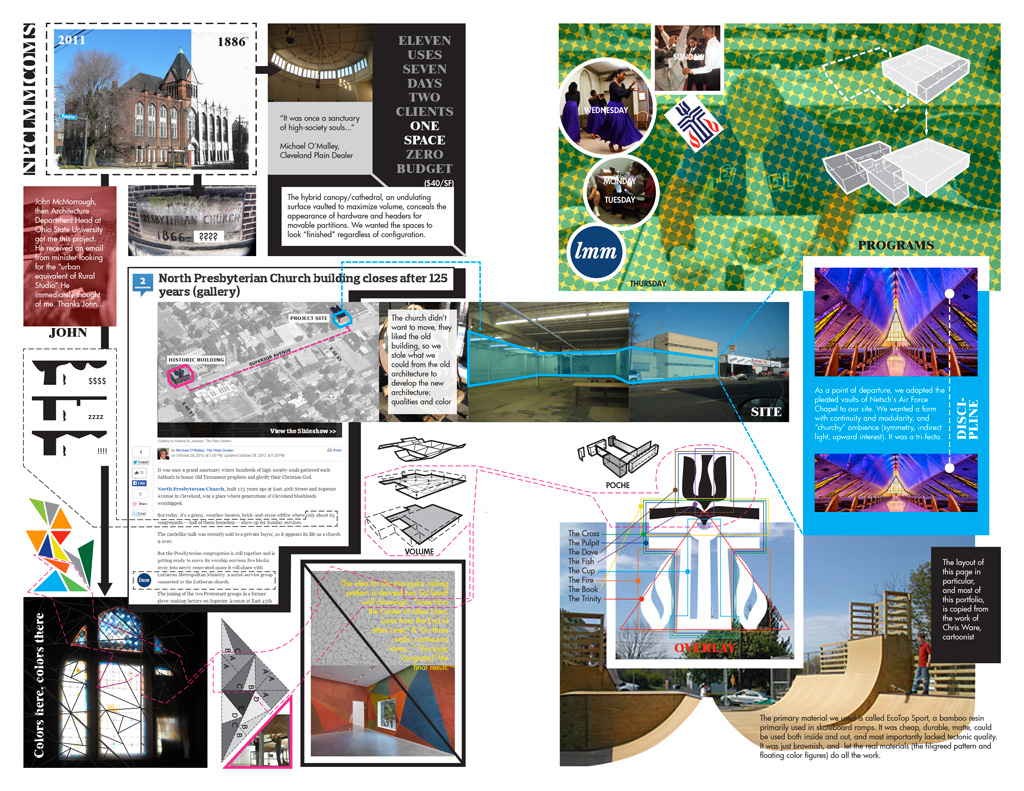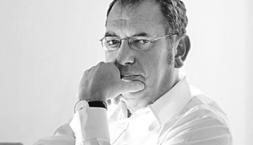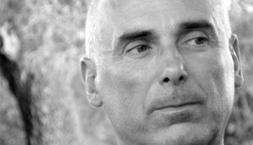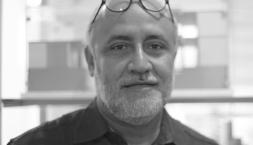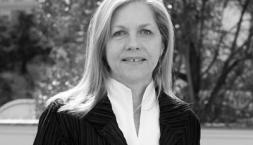Professor in Residence, Department of Architecture, GSD, Harvard University, Cambridge MA, USA
The purpose of this paper is to argue for “practice” as an autonomous object in architecture by rehearsing contemporary attempts at its definition, and offering an alternative. To support the argument, the author utilizes the characterization of objects from the philosophical practice Object Oriented Ontology (OOO). Additionally, exemplars from a realized project designed by the author are used to demonstrate how representations reveal the metaphysical autonomous object of practice from within material projects. The aspiration of this work is to hunt for an object of architecture independent of the polemics and compromises that seek to legitimize practice with academic and professional audiences. The author suggests that the pursuit and articulation of an autonomous practice that exists outside of both the contingent singular building, and the relations to all other architectures that academic discipline demands, is useful in empowering new creative practices in the field.
Practice, like many others terms used in architecture, has a slippery definition that is often confused, conflated, and exchanged for a spectrum “Pr” words that permeate architectural discourse. Project, Profession, Process, Procedure, Precedent, Product, Program, and Problem are all stand-ins for practice on occasion, but by themselves seem inadequate to comprehensively define Practice. Even more problematic is when these terms are stood up as straw men to drive a wedge between practice and its claims to architecture’s autonomy. The bias from the contingency camp that gathers to oppose autonomy is that practice in architecture is at once too dependent and too relational to be capable of claiming authority or distinction over its own domain. It’s useful then to look at recent attempts to situate and define practice in the field as a means to assess its current position and speculate on its redefinition as an autonomous object.
“…I have found that the view of practice as a series of dialectical dualities is an apt model. Analysis of the data has led me to the conclusion that the profession tends to favor one component of each duality while neglecting the other, thus creating an imbalance that can lead to certain problems. The neglected domain is the territory of practice itself, which is why I focus on bringing practice back into the balance, back into dialectic tension with the profession."1
In Dana Cuff’s terms, practice reconciles the oppositions of individual and collective, specialists and generalists, business and art, decision making and making sense. An integral balancing act of profession and discipline, Cuff sees practice as answering the questions of “what” and “how” in architecture with a conciliatory answer (so akin to how sociologists often treat dialectical problems), one that seeks to reunify content, method, form, means, so often separated by disciplinary positions ignorant of the multitude of influences that lie beyond architects’ control, but greatly affect their work. 2 While this position seeks to situate practice as a comprehensive milieu wherein architects design, it transforms practice into a form of mediation—a context that comes into being through the disputes it attempts to resolve. This view seems to marginalize practice’s role in the contract between discipline and profession, a reactionary position overburdened by its obligations and compromises, incapable of exceeding contingency; dialectic tension becomes conflict resolution.
While Cuff’s definition of practice “as a series of projects that an office is organized to attract and to accomplish” 3 ambitiously pursues
comprehensives, it remains merely “about how to take the heat,” 4 a defensive posture in relation to attacks from the profession. At best, this ethos of practice is about getting work, while remaining indifferent to the ambitions of architecture as a cultural field that exceeds that definition. Cuff’s is an engaged and critical practice that can only operate on what is known, and since this definition forecasts its logical conclusion, the question remains whether practice can be definitive yet speculative: “If you have a project, it is the architect who defines the world around him/her. And if you have a practice, it is the world that defines you.” 5
For Peter Eisenman, “practice” is set in opposition to “project,” incapable of overlap. In his explanation, project critiques the status quo of the discipline and the world, and is therefore political and ideological. Project is an intellectual pursuit carried out as a critical meta-narrative that may engage the world at large, but is articulated in a manner to address architects with an epistemological stake in the field. An insider-game, Eisenman’s “meta-project” can only be advanced successively through certain individual projects (commissions and buildings whether built or unbuilt), those who’s parameters are such that the architect can resist or challenge specific, local demands. The architect’s project should resist and avoid consumption by the normative constraints of the profession. Practice, on the other hand, are projects that are so overdetermined, that their tight controls choke out any chance of executing a concept, subsequently undermining possible contributions to the architect’s project. Using his Pinerba Condominium in Italy and the City of Galicia as exemplars in a recent lecture, Eisenman described the former, a housing project, as “practice” while the now renowned landform cultural center was elevated to the status of project. The aesthetic tropes and techniques of Eisenman’s work appear in both projects, but similarities in the multi-scalar shifting grids, sheared juxtaposed forms, and atectonic pastel palette are dismissed as superficial. Although this distinction is not explained thoroughly by Eisenman, one can infer that Pinerba is a recapitulation of earlier work, a cliché, while Galicia is a conceptual advancement, evidenced by Eisenman noting the critic Jeffrey Kipnis, who claimed this as one the first buildings to achieve a “critical affect.” 6
Eisenman’s hard line between contingent practice and autonomous project attempts to subordinate the former as the inferior counterpart of the latter. After establishing this clear distinction, the line becomes fuzzier when he goes on to acknowledge practice’s vital role in the formation of a project. Quoting Manfredo Tafuri, “Peter…I would not have been interested in your architectural project if you hadn’t practiced architecture.” 7 Peter confesses, “I don’t think you can arrive at a project whole. You need to go through the possibilities of practice to arrive at project.” So where does this leave Eisenman’s practice? On the one hand, as an object, a practice can only succumb to the pressures of quotidian professional obligations, surrendering architecture’s resistive or critical force. On the other, practice is a medium for the establishment and enactment of a project, not be mistaken for its raison d’etre, but central to its effectiveness. Eisenman’s definition of practice does seem to support his Post-Functionalist project where the architect “is no longer the originating agent. Objects are seen as ideas independent of man. In this context, man is a discursive function among complex and already formed system of language, which he witnesses, but does not constitute.” 8 Here practice’s usefulness is in giving this language an independent and indifferently determined referent, the information and elements that can be appropriated and indexed by the participant designer. For Eisenman, practice is neither the gas nor the engine driving his project, practice is the grease, a lubricant for his post-human machinic architectural procedures. Practice keeps the project moving.
Trying to fill in the gaps left by the first two cited definitions of practice, it may be useful to assemble the desirous objects of these discourses in an attempt to construct a more complete term: “Practice is the architect defining the world through a series of projects that an office is organized to attract and to accomplish.” Here practice has both an intellectual imperative and a venue for its execution. Although this composite definition begins to have a place, it is less clear whether practice is a situated object or action. Caught between the architect and the office, inexhaustible as either a figure of architect’s imagination or sum of the procedures and activities that brings buildings into being, practice requires further distinction from Eisenman’s project and Cuff’s practice if we are to consider it autonomous.
- “What is proposed here is instead a notion of practice flexible enough to engage the complexity of the real, yet sufficiently secure in its own technical and theoretical bases to go beyond the simple reflection of the real as given. Not a static reflection of the concepts defined elsewhere (either the codes of professional practice or the dictates of ideologically driven theory) but a rigorous forward movement, capable of producing new concepts out of the hard logic of architecture’s working procedures.” 9
Stan Allen offers a third practice, a “material” practice, concerned predominantly with “matter, forces, and material changes” an elastic figure that shapes substance to create “new objects or organizations of matter.” He opposes this with discursive practices that through their hermeneutic and critical function compete with architecture’s predominant material complex. For Allen, ideology and ethics are both external to practice, to be ignored (theory) or neutrally accommodated (ethics). Constituents germane to material practices are the suite of transformational techniques such as projection, notation, calculation that are constant but intermediaries; linkages that direct changes material states and configurations.
Allen’s practice has two forms of material production, at once creating new realities and the concepts that produce them, a recursive algorithm commanded by a forward vector. Defined by the “work itself” practice releases architecture from the introspective search for its own meaning and preservative justifications, instead positioning a performative practice measured by its possible effects on the world. 10 But his conceptualization of practice reaches its limits when challenged to present a point of departure or terminal destination. Allen’s material charge is profoundly useful when literally practicing, that is working on an established and monolithic set of protocols, but is ineffective at formulating practice. It is only when coming to terms with the immaterial that his practice gets purpose.
While Allen’s definition is succinct when dealing with architecture’s relations to the known real, it drifts when coming to terms with the abstract in practice: “Architecture itself is marked by a promiscuous mixture of the real and the abstract: at once characterized by a degree of abstraction, and at the same time directed toward the production of materials and artifacts that are undeniably real.” 11 Here, Allen conveniently drafts abstraction to the service of the real while elsewhere he seems to contradict this, recognizing, rightly so, that architects “work to effect transformations of reality at a distance from the author.” 12 The power of Allen’s argument for practice is contrasted by its greatest risk, the dualism of “simultaneously inhabit(ing) both (real and abstract) worlds” is undermined by the dialectical monism of his “ensemble of procedures.” 13 While Allen pays close attention to the real, in this domain his definition of practice can quickly devolve into a homogenous field of everything happening all at once. It is only in the abstract where practice gives architecture direction and scope. When working on the material real, Allen’s treatment of practice is largely undifferentiated, a uniform and delimited set of tools, imperfect by his own definition, leaving concepts and objects as the products that architecture avails itself. But it is in the remoteness from the real in the regime of abstraction, where the architect begins to have some freedom to develop authority in practice. Incidentally, through his argument for abstraction’s role in material practice, Allen opens the door to practice’s autonomy by suggesting: if architectures only access to the real is indirect, and the means to affecting reality remain abstract, is practice then the domain where architecture asserts its strongest claims to autonomy?
As dialectic for the profession, the medium for the execution of disciplinary project, or as tools for transforming reality through abstraction, contemporary understandings of practice agree that it serves some dual or mediating role in architecture, claiming a territory that it is more than a portfolio of discreet projects or the activities of an office or firm, but less than a purely theoretical or ideological approach. Practice emerges through causal relationships between project and profession, but slips the grasp of either a governing theory developed for a meta-project or narrative, or the mere dealings with circumstances of projects or buildings. It is through the illusiveness of this definition where practice asserts is independence from either pole, and becomes the real object on architecture’s interest.
If one is concerned that the argument that architecture’s foremost preoccupation is the pursuit of a practice, rather than an intellectual project or a collection of material artifacts, is too a radical proposition, think of a “body of work.” Like practice, a body of work is clearly a thing, an object whose essences or qualities are ineffable. A body of work is more than a catalogue or an oeuvre complete, and, although brought into being by the life of an architectural organization, it is not exhausted by interpretations of its content and theories of its existence, and remains discreet nonetheless. As an abstraction, the body of work is also not something an architect works on directly, only obliquely, a peripheral but persistent concern that comes in and out of attention during the pursuits of the task at hand. But it is always there, somewhere. On these terms, “practice” and “body of work” are synonymous in their interactions with architecture as objects, things to which the motivations and sensibilities of architecture are directed. If there is any distinction, it might be in appearance, as practice receives the attention of thoughts and actions in its evolution, while a feelings and emotions are directed at the body of work in its reception. Regardless, practice is being positioned here as an object that has an essence and qualities of its own, beyond complete control, understanding and influence of the discipline, profession, projects, or architects. This metaphysical object is undeniably real, but has qualities that are only made available episodically; a fleeting apparition that enters consciousness amidst architecture’s transactions with reality and abstraction.
This definition of “real object” borrows liberally from philosopher Graham Harman and his philosophical practice Object Oriented Ontology (OOO), whose work has within the last decade entered the architectural imagination. A branch of the philosophical movement known as speculative realism, OOO posits that objects are irreducible entities, that aesthetics is first philosophy, and that reality cannot ultimately be known. More importantly, objects can neither be reduced to their constituent elements and parts, nor to their effects and relations on the world, which constitutes their autonomy. In Harman’s terms, there are two kinds of objects: real and sensual. “Sensual” objects are those that inhabit the phenomenal realm, objects that exist only for another object that encounters them, but whose essences remain inaccessible. The “real object” is autonomous from whatever encounters it, is always withdrawn from experience, but may “emit sensual qualities.” 14
Returning to the task at hand, Harman’s argument can be tested against the posited definition of practice as a real object. First, practices do not exist in the experiential realm. Whether we consider Eisenman’s project, Cuff’s dialectic, or Allen’s tools, practices are autonomous insofar as they withdraw from relations to praxis, and exist beyond their constitution by architects, offices, and projects. And since the qualities of objects are hidden until they “break,” or come into attention from the withdrawn interior realm they principally inhabit, we can imagine practice as an object that exists in the background, one whose form can neither be defined theoretically or pragmatically.
Given their relative tangibility, it may be difficult to think of a building, or this paper, as real immaterial objects, but with practice it becomes easier, precisely because it tends to escape representation. If tasked to draw or describe a practice (paradoxically given the nature of this paper), one finds this effort complicated significantly by the limited appearance of its sensual qualities. In turn, does practice’s autonomy inhibit an architect’s agency in establishing its character? Harman himself suggests the means to quell the anxiety that emerges from this apparent loss of the control. First, humans are but one of an infinite level world of objects, making them a participant rather than the director, and with the four-fold structure of OOO (real/sensual, objects/qualities), the phenomenal world can have influence without knowing essence of a practice. Also, causal relations may have a necessary use in an object’s genesis, although the essence and qualities of the object will ultimately escape and withdraw from the procedures and circumstance of its creation. 15 Nominally, there are similarities between Eisenman’s post humanist project, and the mechanisms of this approach, but where Eisenman’s project sought a multiplication and destabilization of relations between signs and referents indexed from an irreducible language, the objects of OOO are a universe of discreet object to object interactions.
As an autonomous object, architects don’t design practice; they hunt for its qualities and hint at its eidos through the continual production of creative work. A practice can never be made whole by drawings, buildings, or texts as architects work directly on projects and indirectly on a body of work. Practice has its own mysterious form, can only be assessed in retrospect as a thing in and of itself, difficult to paraphrase, and can only be alluded to through representational metaphor. As a field, architecture emotes a love of practice, the real object of affection to which architects direct their efforts, intelligence, and feelings, attempting to demonstrate their love through the creation of sensual architectural objects. 16
In our own practice, SILO AR+D, we have (futilely) searched for appearances of an autonomous form of practice within our work. By continually returning to and revising projects through any medium at our disposal – drawings, models, photographs – we have attempted to explain, fake, ruin, and misinterpret our own work to reveal the hidden character of practice that lurks behind the projects. (Figs. 1, 2, 3, 4, 5) In these collages, diaries, scrapbooks, diagrams, and maps, everything is in play – from the story (real or imagined) of how we got the project and the family of precedents we copy from, to how the architecture may have developed if pursued by imaginary architects using the same concepts. This effort instigates fresh thoughts that create space for us to remember and forget, speculate and plan, think about the current project, and dream what might happen next. The drawings act as a contextualized heuristics and has a pseudo-mathematical function: a machine or method for processing and transforming interactions between disciplines and contingencies. Without ever knowing our practice, this work brings to our attention the tension of ambition, influence, limitation and liability through representation. While not explicitly capable of producing new work, these efforts approach something akin to Harman’s four-fold, hinting at the real autonomous object of our practice.
Dana Cuff, "Architecture: The Story of Practice." (Cambridge MA, USA: MIT Press, 1991),
Ibid., 13.
Ibid., 62.
Ibid., 15.
References and quotes transcribed from the online video recording of the lecture: "Peter Eisenman. Project or Practice?" Syracuse University School of Architecture (April 15, 2013). (Accessed September 30, 2015), https://www.youtube.com/watch?v=TnyJRYyuhHU, (10:00).
Ibid., 40:30.
bid., 41:54.
Peter Eisenman, "Post-Functionalism", Oppositions 6 (Fall 1976).
Allen Stan, Practice: Architecture, Technique Representation. Expanded 2nd ed. (London, UK: Routledge, 2009), XIII.
Ibid., XIV.
Ibid., XVIII.
Ibid., 7.
Ibid., 7.
Graham Harman, The Quadruple Object. (Winchester, UK: Zero Books, 2011), 47-48.
Graham Harman suggests this usage of causality, elegantly, in the question and answer portion of a lecture recently delivered at Syracuse University September 25, 2014. https://soa.syr.edu/live/events/74-graham-harman-with-mark-gage
Graham Harman, The Third Table. (Ostfildern, Ger.: Hatje Cantz, 2012).
Marc Manack, AIA is an Assistant Professor in the Fay Jones School of Architecture at the University of Arkansas, and is founding principal of the award winning architecture and design firm SILO AR+D, which operates out of Cleveland, Ohio and Fayetteville, Arkansas. His research focuses on the relationship between design methods and organizations of practice. Manack is co-editor of the book Out of Scale (ORO, 2015) and co-author of the forthcoming book Postmodern Computation. E-mail: manack@uark.edu



